International Coral Reef Research and Monitoring Center
History of establishment
What is happening to coral reefs?
 In the 1970s and 1980s, coral reefs in Japan suffered great damage from crown-of-thorns starfish, which prey on stony coral polyps. Although the reefs gradually recovered, in 1998, they suffered great damage from coral bleaching, due to rising seawater temperatures and other factors. Additionally, direct-indirect anthropogenic disturbances, e.g., the increase in red-soil runoff from land due to the discharge of wastewater, are exacerbating the living conditions of coral reefs. For the conservation of coral reefs, we need to clarify various environmental factors that affect them, while addressing individual issues.
In the 1970s and 1980s, coral reefs in Japan suffered great damage from crown-of-thorns starfish, which prey on stony coral polyps. Although the reefs gradually recovered, in 1998, they suffered great damage from coral bleaching, due to rising seawater temperatures and other factors. Additionally, direct-indirect anthropogenic disturbances, e.g., the increase in red-soil runoff from land due to the discharge of wastewater, are exacerbating the living conditions of coral reefs. For the conservation of coral reefs, we need to clarify various environmental factors that affect them, while addressing individual issues.
Future of coral reefs for our children
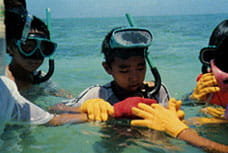 Coral reefs are a treasure trove of biodiversity and must be conserved into the future; this has been the core ideology of institutes such as the International Coral Reef Initiative (ICRI) and the International Coral Reef Research and Monitoring Center. The conservation of coral reefs is considered an urgent issue at the global scale. The ICRI, a comprehensive international program for coral reef conservation, was launched in 1995. One of the major activities of ICRI is the establishment of the Global Coral Reef Monitoring Network, and the International Coral Reef Research and Monitoring Center is expected to serve as a base for the network for not only Japan, but also the East Asian Sea region.
Coral reefs are a treasure trove of biodiversity and must be conserved into the future; this has been the core ideology of institutes such as the International Coral Reef Initiative (ICRI) and the International Coral Reef Research and Monitoring Center. The conservation of coral reefs is considered an urgent issue at the global scale. The ICRI, a comprehensive international program for coral reef conservation, was launched in 1995. One of the major activities of ICRI is the establishment of the Global Coral Reef Monitoring Network, and the International Coral Reef Research and Monitoring Center is expected to serve as a base for the network for not only Japan, but also the East Asian Sea region.
Activity details
1. Collection, organization, and provision of information related to coral reefs
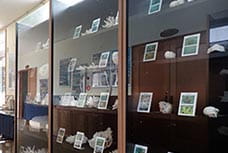
2. Monitoring surveys of coral reefs
Coral reefs can be perceived as an ecosystem that is constantly changing under the influence of various natural and human drivers. Thus, for the conservation of coral reefs, we need to monitor the current status of coral reefs continuously, i.e., conduct continuous monitoring surveys. Our center conducts monitoring surveys for the coral reefs around Ishigaki Island and the Sekisei lagoon, while conducting monitoring surveys at the researcher and citizen levels.3. Public awareness activities
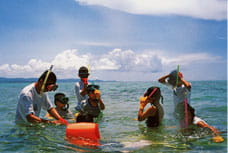 The conservation of coral reefs begins with the understanding of the importance of coral reefs. In addition to holding special exhibitions to present the value and importance of coral reefs and the need for their conservation, we arrange nature-interaction activities at places that present diverse natural biodiversity, e.g., the Iriomote-Ishigaki National Park.
The conservation of coral reefs begins with the understanding of the importance of coral reefs. In addition to holding special exhibitions to present the value and importance of coral reefs and the need for their conservation, we arrange nature-interaction activities at places that present diverse natural biodiversity, e.g., the Iriomote-Ishigaki National Park.Facility guide
We offer access to the material room, along with guided tours of the facilities. The center also has an exhibition space where visitors can view specimens of coral skeletons. The use of the multipurpose lecture room, laboratory, and equipment is available only for the purpose of research and activities related to the conservation of coral reefs and their environment.
Overview of the facilities

- Laboratory
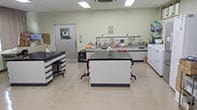 We use state-of-art laboratory and survey equipment, to ensure that our center can support field surveys and novel studies.
We use state-of-art laboratory and survey equipment, to ensure that our center can support field surveys and novel studies.- Multipurpose lecture room
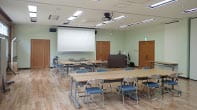 We also have a multipurpose lecture room, where meetings, special exhibitions, lectures, and other events are held.
We also have a multipurpose lecture room, where meetings, special exhibitions, lectures, and other events are held.- Coral specimen shelves
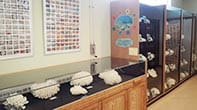 We continue to collect specimens, mainly from the coral reefs in Ishigaki Island and the Sekisei lagoon. These specimens are presented on shelves for visitors and the faculty.
We continue to collect specimens, mainly from the coral reefs in Ishigaki Island and the Sekisei lagoon. These specimens are presented on shelves for visitors and the faculty.- Material room
 We maintain a material room, where visitors can access related books and the results of monitoring surveys.
We maintain a material room, where visitors can access related books and the results of monitoring surveys.
Please contact us if you would like to use our center for conducting surveys and studies on coral reef ecosystems.
How to use our facilities and materials
Facility tours and material viewing
We offer guided tours of the facility and grant access to the materials in the material room, for students, scholars, and visitors alike. Please feel free to visit us.
Use of facilities, materials, and services
The use of our facilities, materials, and services requires permission. You may submit an application stating the objective of your visit. Please review the terms of use before submitting the application. Contact us 14 days before your visit, using the details given below.
Use of facilities
The facilities (laboratory, multipurpose lecture room, material room, break room, etc.) and equipment at the center are available for rent for the purpose of research and activities related to the conservation of coral reefs and the environment.
Click here to view/download the terms of use and the application form regarding the use of our facilities, etc.
Use of materials
Reports, books, photographs, and other materials archived at our center are available for use for conducting studies and activities related to the conservation of coral reefs and the environment.
Click here to view/download the application form for the use of our materials, etc.
Application form
Use of facilities
The facilities (laboratory, multipurpose lecture room, material room, break room, etc.) and equipment at the center are available for rent for the purpose of research and activities related to the conservation of coral reefs and the environment.
To view and download the terms of use and the application form for the use of our facilities, please click on the links give below:
| Terms of use | [PDF format:70KB] | Word [DOC format:39KB] |
|---|---|---|
| Application form | [PDF format:120KB] | Word [DOC format:44KB] |
Use of materials
Reports, books, photographs, and other materials archived at our center are available for use for conducting studies and activities related to the conservation of coral reefs and the environment.
To view and download the terms of use and the application form for the use of our materials, please click on the links give below:
| Terms of use | [PDF format:85KB] | Word [DOC format:41KB] |
|---|---|---|
| Application form | [PDF format:107KB] | Word [DOC format:38KB] |
Click here for details on the use of our facilities and materials
Access and transportation
Overview of the center
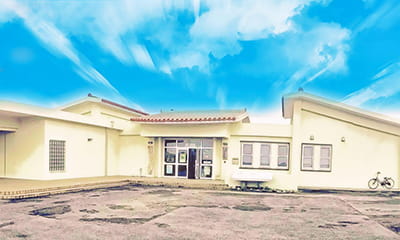
| Name | International Coral Reef Research and Monitoring Center |
|---|---|
| Address | 227 Yashima Town, Ishigaki City, Okinawa Prefecture 9070011, Japan TEL:0980 82 4902 FAX:0980 82 0279 |
| Established on | May 12, 2000 |

Access Map
- 25 min by car from Painushima Ishigaki Airport (9.4㎞)
- 10 min by walk from Maezato Park bus stop (550m)
- 10 min by car from Ishigaki Port Terminal (2.1㎞)
